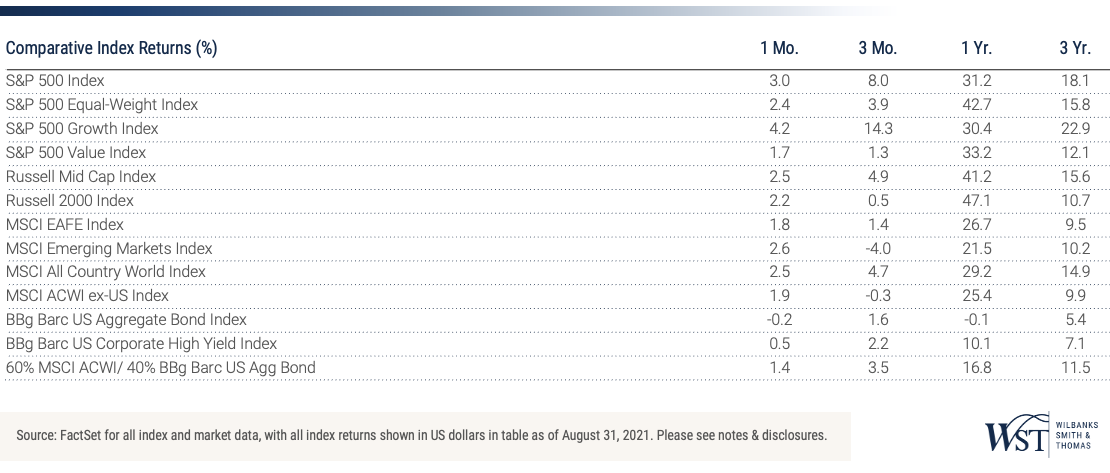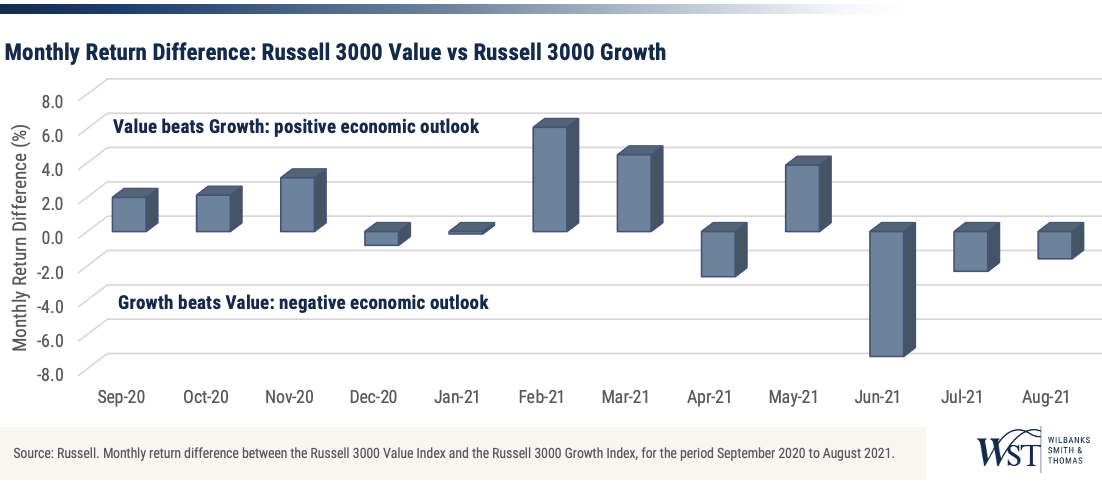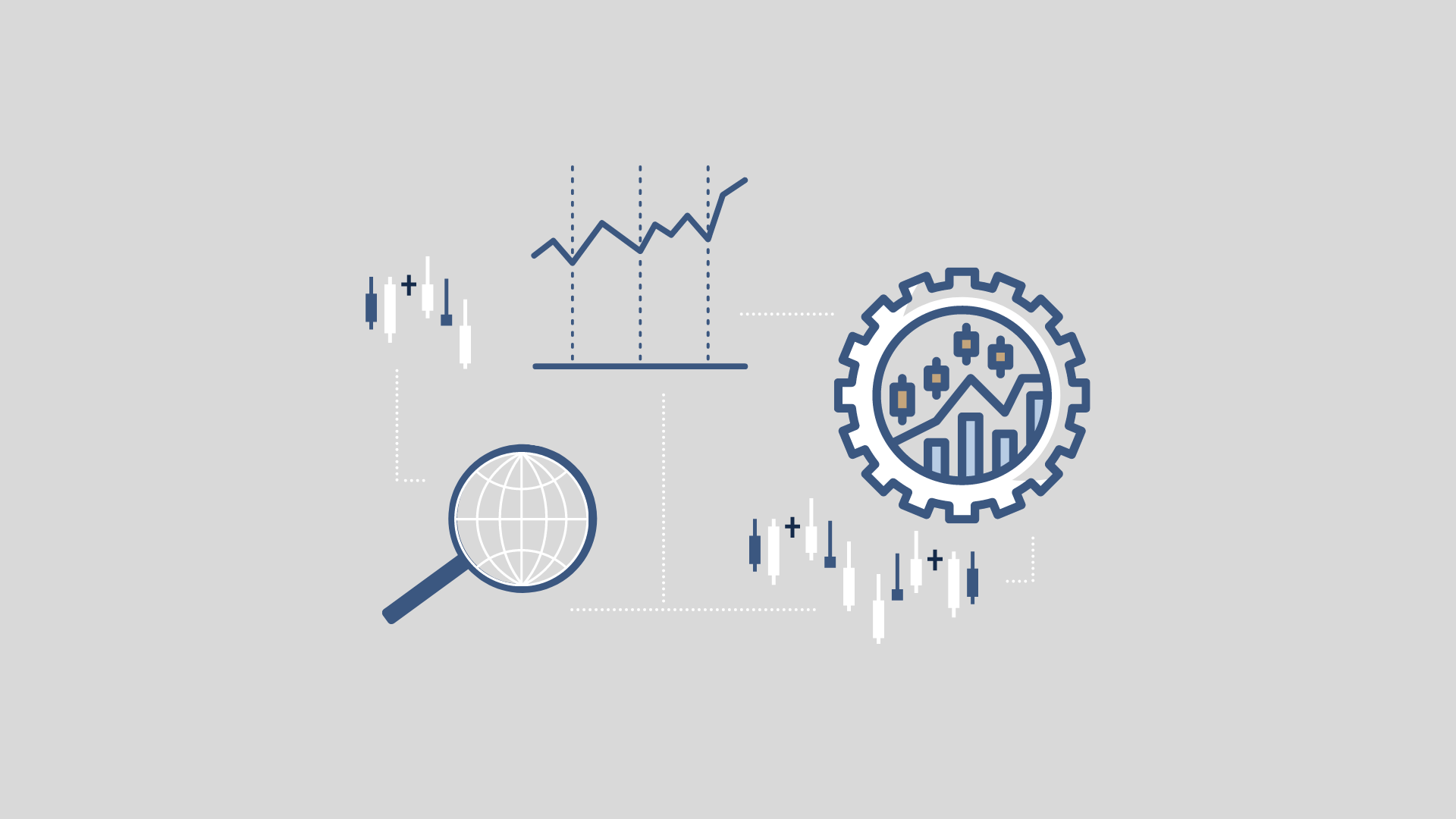August 2021 | Global Equity Markets
August was another positive month for U.S. equities with the S&P 500 Index producing a total return of 3.04% and the seventh consecutive month of positive returns. Record highs for the index were almost the norm in August with 12 of the 22 trading days reaching the paramount of market history.

Such a concentrated burst of higher highs is exceedingly rare with August 2021 in the top 1% of months registering record levels using data back to 1927. Broader market domestic indices lagged with S&P Mid Cap 400 Index returning just 1.95% while the S&P 600 Small Cap Index return for the month was 2.02%. The gap in returns between large and small cap indices narrowed from an unusually wide margin in July. The magnitude of outperformance from the largest stocks in the market has lost its dominance from last year but has not evaporated. As a result, the valuation discount from smaller cap indexes has become increasingly attractive. Using forward earnings estimates, the S&P Mid Cap 400 Index is selling at a 21% discount to the S&P 500 which is in the 93rd percentile of observations back to January 2000. The same holds true for the S&P 600 Small Cap Index which is selling at a 25% discount to the S&P 500 and is in the 96th percentile of observations over the same time period.
The disproportionate impact COVID-19 has on sectors of the economy is well chronicled and continues to be the measuring stick to gauge investor confidence about the future. Similarly, style factors such as growth and value are affected with the former doing well when economic data disappoints and the latter doing well when surprises are to the upside. Despite the record-setting August captured by the S&P 500, factors driving returns underneath the benchmark presented a more mixed picture. Leadership was evident in cyclical industry groups such as transportation, retailing, banks and semiconductors along with more economically defensive groups such as utilities, pharmaceuticals and food & staples retailing. Overall, 10 of 11 sector returns were positive during August except for energy. A clearer pattern was evident across the style boxes of growth and value as the volatility between these two major style groups is at a 20 year high amid investors shifting rapidly depending on the consensus view of the economy. August represented the third consecutive month when growth returned to favor as concerns over the Delta variant and less accommodative conditions set by the Federal Reserve dominated the headlines. The chart below illustrates over the past year how volatile this relationship has become with each style performing best in six of the twelve months.

International markets trailed most U.S. benchmarks with the S&P Global ex-U.S. Index up 2.05% compared to the S&P U.S. Index adding 2.86%. Meanwhile, emerging markets were strong during the month with the S&P Emerging Market Index generating a monthly return of 2.95%. Overall, 44 of the 50 countries tracked in the global benchmarks generated a positive return with Latin America being the laggard in August. The dollar remained stable with a slight positive return after a small decline in July. In last month’s Global Equity Market Review, we mentioned the appealing valuation discount in non-U.S. markets. The catalyst for unlocking the value in international markets is moving closer as the Federal Reserve is expected to pull back on easy monetary policy sooner than other major Central Banks. It is also worth noting after leading other countries during the initial stages of the vaccine rollout, the U.S. has now fallen behind many other developed countries in the percentage of the population being vaccinated.
Overall, the major factors occurring in equity markets in August within and across major market segments suggest no changes to our current strategy. Changes in the economic outlook as well as signals from the Federal Reserve regarding changes to monetary policy will be key signals to monitor during the final months of 2021.
Notes & Disclosures
Index Returns – all shown in US dollars
All returns shown trailing 8/31/2021 for the period indicated. “YTD” refers to the total return as of prior-year end, while the other returns are annualized. 3-month and annualized returns are shown for:
- The S&P 500 index is comprised of large capitalized companies across many sectors and is generally regarded as representative of US stock market and is provided in this presentation in that regard only.
- The S&P 500® Equal Weight Index (EWI) is the equal-weight version of the widely-used S&P 500. The index includes the same constituents as the capitalization weighted S&P 500, but each company in the S&P 500 EWI is allocated a fixed weight - or 0.2% of the index total at each quarterly rebalance. The S&P 500 equal-weight index (S&P 500 EWI) series imposes equal weights on the index constituents included in the S&P 500 that are classified in the respective GICS® sector.
- The S&P 500 Growth Index is comprised of equities from the S&P 500 that exhibit strong growth characteristics and is weighted by market-capitalization.
- The S&P 500 Value Index is a market-capitalization weighted index comprising of equities from the S&P 500 that exhibit strong value characteristics such as book value to price ratio, cash flow to price ratio, sales to price ratio, and dividend yield.
- The Russell 3000 Index tracks the performance of 3000 U.S. corporations, determined by market-capitalization, and represents 98% of the investable equity market in the United States.
- The Russell Mid Cap Index measures the mid-cap segment performance of the U.S. equity market and is comprised of approximately 800 of the smallest securities based on current index membership and their market capitalization.
- The Russell 2000 Index is a market-capitalization weighted index that measures the performance of 2000 small-cap and mid-cap securities. The index was formulated to give investors an unbiased collection of the smallest tradable equities still meeting exchange listing requirements.
- The MSCI All Country World Index provides a measure of performance for the equity market throughout the world and is a free float-adjusted market capitalization weighted index.
- The MSCI EAFE Index is a market-capitalization weighted index and tracks the performance of small to large-cap equities in developed markets of Europe, Australasia, and the Far East.
- The MSCI Emerging Markets Index is a float-adjusted market-capitalization index that measures equity market performance in global emerging markets and cannot be purchased directly by investors.
- The S&P Global BMI sector indices are into sectors as defined by the widely used Global Industry Classification Standards (GICS) classifications. Each sector index comprises those companies included in the S&P Global BMI that are classified as members of respective GICS® sector. The S&P Global BMI Indices were introduced to provide a comprehensive benchmarking system for global equity investors. The S&P Global BMI is comprised of the S&P Emerging BMI and the S&P Developed BMI. It covers approximately 10,000 companies in 46 countries. To be considered for inclusion in the index, all listed stocks within the constituent country must have a float market capitalization of at least $100 million. For a country to be admitted, it must be politically stable and have legal property rights and procedures, among other criteria.
- The Barclay’s US Aggregate Index, a broad-based unmanaged bond index that is generally considered to be representative of the performance of the investment grade, US dollar-denominated, fixed-rate taxable bond market.
- The Bloomberg Barclay’s US Corporate High Yield Index, which covers the USD-denominated, non-investment grade, fixed-rate, taxable corporate bond market.
An index is a portfolio of specific securities, the performance of which is often used as a benchmark in judging the relative performance to certain asset classes. Index performance used throughout is intended to illustrate historical market trends and performance. Indexes are managed and do not incur investment management fees. An investor is unable to invest in an index. Their performance does not reflect the expenses associated with the management of an actual portfolio. No strategy assures success or protects against loss. There is no guarantee that a diversified portfolio will enhance overall returns or outperform a non-diversified portfolio. Diversification does not protect against market risk. All investing involves risk including loss of principal. Investing in stock includes numerous specific risks including: the fluctuation of dividend, loss of principal, and potential liquidity of the investment in a falling market. Past performance is no guarantee of future results.
Key Indicators
Key Indicators correspond to various macro-economic and rate-related data points that we consider impactful to equity markets.
- The US 10-Year Treasury Yield (%)/bps, is the return on investment for the U.S. government’s 10-year debt obligation and serves as a signal for investor confidence.
- SPDR Gold Trust Price ($), is an investment fund that reflects the performance on the price of a gold bullion, less the Trust’s expenses.
- West Texas Intermediate, which is an oil benchmark and the underlying asset in the New York Mercantile Exchange’s oil futures contract.
- CBOE Volatility Index (Level)/% Change, which uses price options on the S&P 500 to estimate the market's expectation of 30-day volatility.
General Disclosure
Wilbanks, Smith & Thomas Asset Management (WST) is an investment adviser registered under the Investment Advisers Act of 1940. Registration as an investment adviser does not imply any level of skill or training. The information presented in the material is general in nature and is not designed to address your investment objectives, financial situation or particular needs. Prior to making any investment decision, you should assess, or seek advice from a professional regarding whether any particular transaction is relevant or appropriate to your individual circumstances. This material is not intended to replace the advice of a qualified tax advisor, attorney, or accountant. Consultation with the appropriate professional should be done before any financial commitments regarding the issues related to the situation are made.
This document is intended for informational purposes only and should not be otherwise disseminated to other third parties. Past performance or results should not be taken as an indication or guarantee of future performance or results, and no representation or warranty, express or implied is made regarding future performance or results. This document does not constitute an offer to sell, or a solicitation of an offer to purchase, any security, future or other financial instrument or product. This material is proprietary and being provided on a confidential basis, and may not be reproduced, transferred or distributed in any form without prior written permission from WST. WST reserves the right at any time and without notice to change, amend, or cease publication of the information. The information contained herein includes information that has been obtained from third party sources and has not been independently verified. It is made available on an "as is" basis without warranty and does not represent the performance of any specific investment strategy.
Some of the information enclosed may represent opinions of WST and are subject to change from time to time and do not constitute a recommendation to purchase and sale any security nor to engage in any particular investment strategy. The information contained herein has been obtained from sources believed to be reliable but cannot be guaranteed for accuracy.
Besides attributed information, this material is proprietary and may not be reproduced, transferred or distributed in any form without prior written permission from WST. WST reserves the right at any time and without notice to change, amend, or cease publication of the information. This material has been prepared solely for informative purposes. The information contained herein may include information that has been obtained from third party sources and has not been independently verified. It is made available on an “as is” basis without warranty. This document is intended for clients for informational purposes only and should not be otherwise disseminated to other third parties. Past performance or results should not be taken as an indication or guarantee of future performance or results, and no representation or warranty, express or implied is made regarding future performance or results. This document does not constitute an offer to sell, or a solicitation of an offer to purchase, any security, future or other financial instrument or product.
